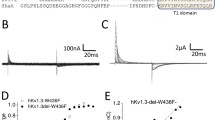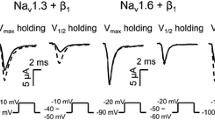Abstract
Objective
In this study, the pharmacological kinetics of Buthus martensi Karsch (BmK) AS, a specific modulator of voltage-gated sodium channel site 4, was investigated on Nav1.3 expressed in Xenopus oocytes.
Methods
Two-electrode voltage clamp was used to record the whole-cell sodium current.
Results
The peak currents of Nav1.3 were depressed by BmK AS over a wide range of concentrations (10, 100, and 500 nmol/L). Most remarkably, BmK AS at 100 nmol/L hyperpolarized the voltage-dependence and increased the voltage-sensitivity of steady-state activation/inactivation. In addition, BmK AS was capable of hyperpolarizing not only the fast inactivation but also the slow inactivation, with a greater preference for the latter. Moreover, BmK AS accelerated the time constant and increased the ratio of recovery in Nav1.3 at all concentrations.
Conclusion
This study provides direct evidence that BmK AS facilitates steady-state activation and inhibits slow inactivation by stabilizing both the closed and open states of the Nav1.3 channel, which might result from an integrative binding to two receptor sites on the voltage-gated sodium channels. These results may shed light on therapeutics against Nav1.3-targeted pathology.
Similar content being viewed by others
References
Franceschetti S, Guatteo E, Panzica F, Sancini G, Wanke E, Avanzini G. Ionic mechanisms underlying burst firing in pyramidal neurons: intracellular study in rat sensorimotor cortex. Brain Res 1995, 696: 127–139.
Alonso A, Llinas RR. Subthreshold Na+-dependent theta-like rhythmicity in stellate cells of entorhinal cortex layer II. Nature 1989, 342: 175–177.
Klink R, Alonso A. Ionic mechanisms for the subthreshold oscillations and differential electroresponsiveness of medial entorhinal cortex layer II neurons. J Neurophysiol 1993, 70: 144–157.
Silva LR, Amitai Y, Connors BW. Intrinsic oscillations of neocortex generated by layer 5 pyramidal neurons. Science 1991, 251: 432–435.
Crill WE. Persistent sodium current in mammalian central neurons. Annu Rev Physiol 1996, 58: 349–362.
Catterall WA. Cellular and molecular biology of voltage-gated sodium channels. Physiol Rev 1992, 72: S15–48.
Catterall WA. Structure and function of voltage-gated ion channels. Annu Rev Biochem 1995, 64: 493–531.
Beckh S, Noda M, Lubbert H, Numa S. Differential regulation of three sodium channel messenger RNAs in the rat central nervous system during development. EMBO J 1989, 8: 3611–3616.
Black JA, Waxman SG. Sodium channel expression: a dynamic process in neurons and non-neuronal cells. Dev Neurosci 1996, 18: 139–152.
Felts PA, Yokoyama S, Dib-Hajj S, Black JA, Waxman SG. Sodium channel alpha-subunit mRNAs I, II, III, NaG, Na6 and hNE (PN1): different expression patterns in developing rat nervous system. Brain Res Mol Brain Res 1997, 45: 71–82.
Holland KD, Kearney JA, Glauser TA, Buck G, Keddache M, Blankston JR, et al. Mutation of sodium channel SCN3A in a patient with cryptogenic pediatric partial epilepsy. Neurosci Lett 2008, 433: 65–70.
Black JA, Cummins TR, Plumpton C, Chen YH, Hormuzdiar W, Clare JJ, et al. Upregulation of a silent sodium channel after peripheral, but not central, nerve injury in DRG neurons. J Neurophysiol 1999, 82: 2776–2785.
Dib-Hajj SD, Fjell J, Cummins TR, Zheng Z, Fried K, LaMotte R, et al. Plasticity of sodium channel expression in DRG neurons in the chronic constriction injury model of neuropathic pain. Pain 1999, 83: 591–600.
Hains BC, Saab CY, Klein JP, Craner MJ, Waxman SG. Altered sodium channel expression in second-order spinal sensory neurons contributes to pain after peripheral nerve injury. J Neurosci 2004, 24: 4832–4839.
Kamata K, Kirisawa H. Changes in electrophysiological properties and noradrenaline response in vas deferens of diabetic rats. Eur J Pharmacol 1998, 350: 237–241.
Hains BC, Klein JP, Saab CY, Craner MJ, Black JA, Waxman SG. Upregulation of sodium channel Nav1.3 and functional involvement in neuronal hyperexcitability associated with central neuropathic pain after spinal cord injury. J Neurosci 2003, 23: 8881–8892.
Lampert A, Hains BC, Waxman SG. Upregulation of persistent and ramp sodium current in dorsal horn neurons after spinal cord injury. Exp Brain Res 2006, 174: 660–666.
Kim CH, Oh Y, Chung JM, Chung K. The changes in expression of three subtypes of TTX sensitive sodium channels in sensory neurons after spinal nerve ligation. Brain Res Mol Brain Res 2001, 95: 153–161.
Estacion M, Gasser A, Dib-Hajj SD, Waxman SG. A sodium channel mutation linked to epilepsy increases ramp and persistent current of Nav1.3 and induces hyperexcitability in hippocampal neurons. Exp Neurol 224: 362–368.
Guo F, Yu N, Cai JQ, Quinn T, Zong ZH, Zeng YJ, et al. Voltage-gated sodium channel Nav1.1, Nav1.3 and beta1 subunit were up-regulated in the hippocampus of spontaneously epileptic rat. Brain Res Bull 2008, 75: 179–187.
Patton DE, Isom LL, Catterall WA, Goldin AL. The adult rat brain beta 1 subunit modifies activation and inactivation gating of multiple sodium channel alpha subunits. J Biol Chem 1994, 269: 17649–17655.
Feng XH, Chen JX, Liu Y, Ji YH. Electrophysiological characterization of BmK I, an alpha-like scorpion toxin, on rNav1.5 expressed in HEK293t cells. Toxicol In Vitro 2008, 22: 1582–1587.
He H, Liu Z, Dong B, Zhou J, Zhu H, Ji Y. Molecular determination of selectivity of the site 3 modulator (BmK I) to sodium channels in the CNS: a clue to the importance of Nav1.6 in BmK I-induced neuronal hyperexcitability. Biochem J 2010, 431: 289–298.
Tan ZY, Xiao H, Mao X, Wang CY, Zhao ZQ, Ji YH. The inhibitory effects of BmK IT2, a scorpion neurotoxin on rat nociceptive flexion reflex and a possible mechanism for modulating voltage-gated Na+ channels. Neuropharmacology 2001, 40: 352–357.
Zhu MM, Tao J, Tan M, Yang HT, Ji YH. U-shaped dose-dependent effects of BmK AS, a unique scorpion polypeptide toxin, on voltage-gated sodium channels. Br J Pharmacol 2009, 159: 1895–1903.
Chen B, Ji Y. Antihyperalgesia effect of BmK AS, a scorpion toxin, in rat by intraplantar injection. Brain Res 2002, 952: 322–326.
Chen J, Feng XH, Shi J, Tan ZY, Bai ZT, Liu T, et al. The anti-nociceptive effect of BmK AS, a scorpion active polypeptide, and the possible mechanism on specifically modulating voltage-gated Na+ currents in primary afferent neurons. Peptides 2006, 27: 2182–2192.
Liu T, Pang XY, Jiang F, Bai ZT, Ji YH. Anti-nociceptive effects induced by intrathecal injection of BmK AS, a polypeptide from the venom of Chinese-scorpion Buthus martensi Karsch, in rat formalin test. J Ethnopharmacol 2008, 117: 332–338.
Zhao R, Weng CC, Feng Q, Chen L, Zhang XY, Zhu HY, et al. Anticonvulsant activity of BmK AS, a sodium channel site 4-specific modulator. Epilepsy Behav 2011, 20: 267–276.
Tan M, Zhu MM, Liu Y, Cheng HW, Ji YH. Effects of BmK AS on Nav1.2 expressed in Xenopus laevis oocytes. Cell Biol Toxicol 2008, 24: 143–149.
Tan ZY, Chen J, Shun HY, Feng XH, Ji YH. Modulation of BmK AS, a scorpion neurotoxic polypeptide, on voltage-gated Na+ channels in B104 neuronal cell line. Neurosci Lett 2003, 340: 123–126.
Liu YR, Ren H M, Ji Y H, Ohishi T, Mochizuki T, Hoahino M, et al. Purification and the partial amino acid sequence of a novel activator of ryanodine (bmk as-1) from mammalian skeletal muscle. Biomed Res 1996, 17: 451–455.
Ji YH, Mansuelle P, Terakawa S, Kopeyan C, Yanaihara N, Hsu K, et al. Two neurotoxins (BmK I and BmK II) from the venom of the scorpion Buthus martensi Karsch: purification, amino acid sequences and assessment of specific activity. Toxicon 1996, 34: 987–1001.
Goldin AL. Expression of ion channels by injection of mRNA into Xenopus oocytes. Methods Cell Biol 1991, 36: 487–509.
Shichor I, Zlotkin E, Ilan N, Chikashvili D, Stuhmer W, Gordon D, et al. Domain 2 of Drosophila para voltage-gated sodium channel confers insect properties to a rat brain channel. J Neurosci 2002, 22: 4364–4371.
Smith MR, Smith RD, Plummer NW, Meisler MH, Goldin AL. Functional analysis of the mouse Scn8a sodium channel. J Neurosci 1998, 18: 6093–6102.
Cummins TR, Aglieco F, Renganathan M, Herzog RI, Dib-Hajj SD, Waxman SG. Nav1.3 sodium channels: rapid repriming and slow closed-state inactivation display quantitative differences after expression in a mammalian cell line and in spinal sensory neurons. J Neurosci 2001, 21: 5952–5961.
Meadows LS, Chen YH, Powell AJ, Clare JJ, Ragsdale DS. Functional modulation of human brain Nav1.3 sodium channels, expressed in mammalian cells, by auxiliary beta 1, beta 2 and beta 3 subunits. Neuroscience 2002, 114: 745–753.
John VH, Main MJ, Powell AJ, Gladwell ZM, Hick C, Sidhu HS, et al. Heterologous expression and functional analysis of rat Nav1.8 (SNS) voltage-gated sodium channels in the dorsal root ganglion neuroblastoma cell line ND7-23. Neuropharmacology 2004, 46: 425–438.
Gordon D, Ilan N, Zilberberg N, Gilles N, Urbach D, Cohen L, et al. An ‘Old World’ scorpion beta-toxin that recognizes both insect and mammalian sodium channels. Eur J Biochem 2003, 270: 2663–2670.
Li YJ, Liu Y, Ji YH. BmK AS: new scorpion neurotoxin binds to distinct receptor sites of mammal and insect voltage-gated sodium channels. J Neurosci Res 2000, 61: 541–548.
Jia LY, Zhang JW, Ji YH. Biosensor binding assay of BmK AS-1, a novel Na+ channel-blocking scorpion ligand on rat brain synaptosomes. Neuroreport 1999, 10: 3359–3362.
Liu ZR, Ye P, Ji YH. Exploring the obscure profiles of pharmacological binding sites on voltage-gated sodium channels by Bmk neurotoxins. Protein Cell 2011, 2: 437–444.
Cestele S, Catterall WA. Molecular mechanisms of neurotoxin action on voltage-gated sodium channels. Biochimie 2000, 82: 883–892.
Zuo XP, Ji YH. Molecular mechanism of scorpion neurotoxins acting on sodium channels: insight into their diverse selectivity. Mol Neurobiol 2004, 30: 265–278.
de la Vega RC, Possani LD. Novel paradigms on scorpion toxins that affects the activating mechanism of sodium channels. Toxicon 2007, 49: 171–180.
Ulbricht W. Sodium channel inactivation: molecular determinants and modulation. Physiol Rev 2005, 85: 1271–1301.
Tan ZY, Chen J, Feng XH, Susumu T, Ji YH. Modulation of intracellular Na+ concentration by BmK AS, a scorpion toxin, in B104 cell line. Neuroreport 2004, 15: 13–16.
Oh Y, Waxman SG. Novel splice variants of the voltage-sensitive sodium channel alpha subunit. Neuroreport 1998, 9: 1267–1272.
Author information
Authors and Affiliations
Corresponding author
Rights and permissions
About this article
Cite this article
Liu, ZR., Tao, J., Dong, BQ. et al. Pharmacological kinetics of BmK AS, a sodium channel site 4-specific modulator on Nav1.3. Neurosci. Bull. 28, 209–221 (2012). https://doi.org/10.1007/s12264-012-1234-6
Received:
Accepted:
Published:
Issue Date:
DOI: https://doi.org/10.1007/s12264-012-1234-6




